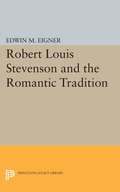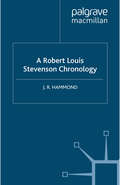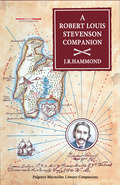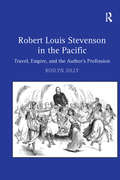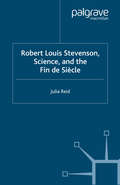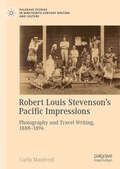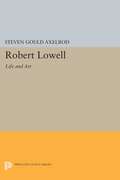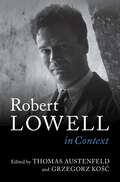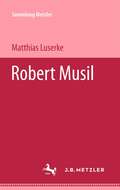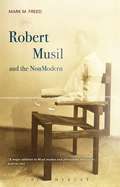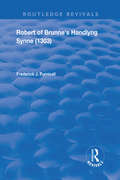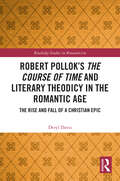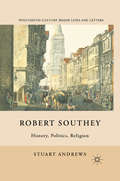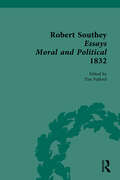- Table View
- List View
Robert Louis Stevenson and the Romantic Tradition
by Edwin M. EignerStevenson's fiction is evaluated in the light of the significant Romantic traditions that have influenced the novel and the romance. Stevenson is also considered as a serious writer and compared with Joseph Conrad, Mark Twain, and other major writers of the period.Originally published in 1966.The Princeton Legacy Library uses the latest print-on-demand technology to again make available previously out-of-print books from the distinguished backlist of Princeton University Press. These editions preserve the original texts of these important books while presenting them in durable paperback and hardcover editions. The goal of the Princeton Legacy Library is to vastly increase access to the rich scholarly heritage found in the thousands of books published by Princeton University Press since its founding in 1905.
Robert Louis Stevenson and theories of reading: The reader as vagabond
by Glenda NorquayRobert Louis Stevenson and theories of reading is both an exceptionally well researched study of the novelist, and well as an intriguing exploration of 'literary consumption'.Glenda Norquay presents fresh interpretations of Stevenson’s literary essays, of major works including The Master of Ballantrae, and some of his more neglected fiction such as St Ives and The Wrecker, as well as illuminating our understanding of his role within debates over popular fiction, romance and reading pleasure. She offers an unusual combination of literary history and reception theory and argues that Stevenson both exemplified tensions within the literary market of his time and anticipated later developments in reading theory. By combining the study of nineteenth-century cultural politics with detailed analysis of his Scottish Calvinism, Stevenson is reassessed as both a Victorian and Scottish writer.The book is aimed at scholars, postgraduates and undergraduates with an interest in the nineteenth-century literary marketplace, in Scottish culture, and in reading /reception theory as well as Stevenson enthusiasts.
A Robert Louis Stevenson Chronology (Author Chronologies Series)
by J. HammondStevenson died at the age of 44, but despite such a short span he lived an incredibly active life during which he travelled widely and wrote a prodigious amount of fiction, essays and poetry. To browse through this Chronology is to follow in the footsteps of a man who was always on the move, always eager to journey onto the next place or to embark on a new literary project. J.R. Hammond, a lifelong student of Stevenson and author of A Robert Louis Stevenson Companion, offers a definitive chronology of RLS which takes account of the latest research into his life and times.
A Robert Louis Stevenson Companion: A Guide to the Novels, Essays and Short Stories (Literary Companions)
by J R HammondRobert Louis Stevenson in the Pacific: Travel, Empire, and the Author's Profession
by Roslyn JollyRobert Louis Stevenson's departure from Europe in 1887 coincided with a vocational crisis prompted by his father's death. Impatient with his established identity as a writer, Stevenson was eager to explore different ways of writing, at the same time that living in the Pacific stimulated a range of latent intellectual and political interests. Roslyn Jolly examines the crucial period from 1887 to 1894, focusing on the self-transformation wrought in Stevenson's Pacific travel-writing and political texts. Jolly shows how Stevenson's desire to understand unfamiliar Polynesian and Micronesian cultures, and to record and intervene in the politics of Samoa, gave him opportunities to use his legal education, pursue his interest in historiography, and experiment with anthropology and journalism. Thus as his geographical and cultural horizons expanded, Stevenson's professional sphere enlarged as well, stretching the category of authorship in which his successes as a novelist had placed him. Rather than enhancing his stature as a popular writer, however, Stevenson's experiments with new styles and genres, and the Pacific subject matter of his later works, were resisted by his readers. Jolly's analysis of contemporary responses to Stevenson's writing, gleaned from an extensive collection of reviews, many of which are not readily available, provides fascinating insights into the interests, obsessions, and resistances of Victorian readers. As Stevenson sought to escape the vocational straightjacket that confined him, his readers just as strenuously expressed their loyalty to outmoded images of Stevenson the author, and their distrust of the new guises in which he presented himself.
Robert Louis Stevenson in the Pacific: Travel, Empire, and the Author's Profession
by Roslyn JollyRobert Louis Stevenson's departure from Europe in 1887 coincided with a vocational crisis prompted by his father's death. Impatient with his established identity as a writer, Stevenson was eager to explore different ways of writing, at the same time that living in the Pacific stimulated a range of latent intellectual and political interests. Roslyn Jolly examines the crucial period from 1887 to 1894, focusing on the self-transformation wrought in Stevenson's Pacific travel-writing and political texts. Jolly shows how Stevenson's desire to understand unfamiliar Polynesian and Micronesian cultures, and to record and intervene in the politics of Samoa, gave him opportunities to use his legal education, pursue his interest in historiography, and experiment with anthropology and journalism. Thus as his geographical and cultural horizons expanded, Stevenson's professional sphere enlarged as well, stretching the category of authorship in which his successes as a novelist had placed him. Rather than enhancing his stature as a popular writer, however, Stevenson's experiments with new styles and genres, and the Pacific subject matter of his later works, were resisted by his readers. Jolly's analysis of contemporary responses to Stevenson's writing, gleaned from an extensive collection of reviews, many of which are not readily available, provides fascinating insights into the interests, obsessions, and resistances of Victorian readers. As Stevenson sought to escape the vocational straightjacket that confined him, his readers just as strenuously expressed their loyalty to outmoded images of Stevenson the author, and their distrust of the new guises in which he presented himself.
Robert Louis Stevenson, Science, and the Fin de Siècle (Palgrave Studies in Nineteenth-Century Writing and Culture)
by J. ReidIn this fascinating book, Reid examines Robert Louis Stevenson's writings in the context of late-Victorian evolutionist thought, arguing that an interest in 'primitive' life is at the heart of his work. She investigates a wide range of Stevenson's writing, including Dr Jekyll and Mr Hyde and Treasure Island as well as previously unpublished material from the Stevenson archive at Yale. Reid's interpretation offers a new way of understanding the relationship between his Scottish and South Seas work. Her analysis of Stevenson's engagement with anthropological and psychological debate also illuminates the dynamic intersections between literature and science at the fin de siècle.
Robert Louis Stevenson’s Pacific Impressions: Photography and Travel Writing, 1888–1894 (Palgrave Studies in Nineteenth-Century Writing and Culture)
by Carla ManfrediThis book tackles photography’s role during Robert Louis Stevenson’s travels throughout the Pacific Island region and is the first study of his family’s previously unpublished photographs. Cutting across disciplinary boundaries, the book integrates photographs with letters, non-fiction, and poetry, and includes much unpublished material. The original readings of photographs and non-fiction highlight Stevenson’s engagement with colonial ideology and reality and advance new arguments about Victorian travel, settlement, and colonialisms in the Pacific. Like the Stevensons, the book moves from the Marquesas to the atolls of the Gilbert Islands in Micronesia; from the Kingdom of Hawai‘i’s political ambitions to Samoan plantations and the Stevensons’ settlement at Vailima. Central to this study is the notion that Pacific history and Pacific Island cultures matter to the interpretation of Stevenson's work, and a rigorous historical and cultural contextualization ensures that local details structure literary and photographic interpretation. The book’s historical grounding is key to its insightful conclusions regarding travel, settlement, photography, and colonialism.
Robert Lowell: Life and Art
by Steven Gould AxelrodThis major interpretation of the life and art of Robert Lowell exposes the full relationship between the poetry and the personal and national experience to which it is so remarkably connected. Steven Axelrod proposes that the key to our understanding of Lowell's poetic achievement lies precisely in this interpenetration of his life and his art.Originally published in 1978.The Princeton Legacy Library uses the latest print-on-demand technology to again make available previously out-of-print books from the distinguished backlist of Princeton University Press. These editions preserve the original texts of these important books while presenting them in durable paperback and hardcover editions. The goal of the Princeton Legacy Library is to vastly increase access to the rich scholarly heritage found in the thousands of books published by Princeton University Press since its founding in 1905.
Robert Lowell In Context (Literature in Context)
by Thomas Austenfeld Grzegorz KośćRobert Lowell was one of the most influential American poets of the 20th century. This volume explores the various contexts of Lowell's life and work and evaluates his oeuvre from new perspectives. Individual chapters address his relation to the South, his religious evolution, aspects of his marriages and private life, his bipolar disorder seen through new theories of mental illness, his work as a letter writer and a connoisseur of art and photography. The book also introduces new parameters for a contemporary study of Lowell, commenting on current debates about race and privilege, feminism, ecoconsciousness, his engagement with the natural environment as well as his friendships with Randall Jarrell and Robert Penn Warren.
Robert Musil (Sammlung Metzler)
by Matthias LuserkeMatthias Luserke legt die erste wissenschaftliche Einführung in das Werk des österreichischen Schriftstellers Robert Musil vor. Neben dem 'Mann ohne Eigenschaften' werden auch der 'Törleß', die Essays, Theaterstücke, die kurze Prosa und der Nachlass gebührend vorgestellt. Luserke gibt Anregungen für eine neue Lesart des Musilschen Werks und versucht, die Musil-Forschung aus ihrer jahrzehntelangen Isolation herauszuführen und an derzeitige literaturwissenschaftliche Standards anzuschließen. Ein beigefügtes Stichwortregister zum Mann ohne Eigenschaften hilft, diesen Roman zu erschließen.
Robert Musil and the NonModern
by Mark M. FreedMusil's novel The Man Without Qualities is widely recognized as a monument of modernist literature alongside Remembrance of Things Past and Ulysses. But while Musil is a major scholarly industry in the German-speaking world, critical attention from English-speaking scholars remains disproportionately small. Moreover, there has been little engagement with Musil's contribution to cultural theory from those working outside literary studies. Freed brings Musil into dialogue with such critics of the modern as Nietzsche, Heidegger, Derrida, and Lyotard and argues that Musil's theory and literary performance of essayism constitutes a strategy of nonmodernity: that is, an engagement with the problems of modernity that does not re-inscribe the distinctions on which modernism grounded itself.This book not only offers an understanding of Musil's essayism made possible by Latour's account of modernity: it also articulates what the discursive and cultural project of nonmodernity might look like. The book thereby introduces Musil scholars and those working in the problematics of postmodernism to one another's interests.
Robert of Brunne's Handlyng Synne: And its French Original (Routledge Revivals)
by Frederick J. FurnivallPublished in 1901, this book provides an English and French version of the 1303 text by Robert Manning of Brunne. Handlyng Synne was adapted from an Anglo-Norman work attributed to William of Waddington, the Manuel de Pechiez. It consists of more than 12,000 lines of verse, arranged in four-stress couplets. It is a discussion of the ten commandments, the seven deadly sins, the seven sacraments, and the elements of confession, illustrated throughout by exempla, or moral anecdotes, thirteen of which do not appear in the Manuel. Handlyng Synne has been described as "a reduction of the world's experience to a comprehensive moral scheme"
Robert of Brunne's Handlyng Synne: And its French Original (Routledge Revivals)
by Frederick J. FurnivallPublished in 1901, this book provides an English and French version of the 1303 text by Robert Manning of Brunne. Handlyng Synne was adapted from an Anglo-Norman work attributed to William of Waddington, the Manuel de Pechiez. It consists of more than 12,000 lines of verse, arranged in four-stress couplets. It is a discussion of the ten commandments, the seven deadly sins, the seven sacraments, and the elements of confession, illustrated throughout by exempla, or moral anecdotes, thirteen of which do not appear in the Manuel. Handlyng Synne has been described as "a reduction of the world's experience to a comprehensive moral scheme"
Robert Pollok’s The Course of Time and Literary Theodicy in the Romantic Age: The Rise and Fall of a Christian Epic (Routledge Studies in Romanticism)
by Deryl DavisThis book explores the contexts and reception history of Robert Pollok’s religious epic The Course of Time (1827), one of the best- selling long poems of the nineteenth century, which has been almost entirely forgotten today. Widely read in the United States and across the British Empire, the poem’s combination of evangelical Calvinism, High Romanticism, and native Scottishness proved irresistible to many readers. This monograph traces the poem’s origins as a defense of Biblical authority, divine providence, and religious orthodoxy (against figures like Byron and Joseph Priestley) and explores the reasons for The Course of Time’s enormous, decades- long popularity and later precipitous decline. A close reading of the poem and an examination of its reception history offers readers important insights into the dynamic relationship between religion and wider culture in the nineteenth century, the uses of literature as a vehicle for theological argument and theodicy, and the important but often overlooked role that religion played in literary— and, particularly, Scottish— Romanticism. This work will appeal to scholars of religious history, literary history, Evangelicalism, Romanticism, Scottish literature, and nineteenth- century culture.
Robert Pollok’s The Course of Time and Literary Theodicy in the Romantic Age: The Rise and Fall of a Christian Epic (Routledge Studies in Romanticism)
by Deryl DavisThis book explores the contexts and reception history of Robert Pollok’s religious epic The Course of Time (1827), one of the best- selling long poems of the nineteenth century, which has been almost entirely forgotten today. Widely read in the United States and across the British Empire, the poem’s combination of evangelical Calvinism, High Romanticism, and native Scottishness proved irresistible to many readers. This monograph traces the poem’s origins as a defense of Biblical authority, divine providence, and religious orthodoxy (against figures like Byron and Joseph Priestley) and explores the reasons for The Course of Time’s enormous, decades- long popularity and later precipitous decline. A close reading of the poem and an examination of its reception history offers readers important insights into the dynamic relationship between religion and wider culture in the nineteenth century, the uses of literature as a vehicle for theological argument and theodicy, and the important but often overlooked role that religion played in literary— and, particularly, Scottish— Romanticism. This work will appeal to scholars of religious history, literary history, Evangelicalism, Romanticism, Scottish literature, and nineteenth- century culture.
Robert Seymour and Nineteenth-Century Print Culture: Sketches by Seymour and Comic Illustration (Routledge Studies in Nineteenth Century Literature)
by Brian MaidmentRobert Seymour and Nineteenth-Century Print Culture is the first book-length study of the original illustrator of Dickens’s Pickwick Papers. Discussion of the range and importance of Seymour’s work as a jobbing illustrator in the 1820s and 1830s is at the centre of the book. A bibliographical study of his prolific output of illustrations in many different print genres is combined with a wide-ranging account of his major publications. Seymour’s extended work for The Comic Magazine, New Readings of Old Authors and Humorous Sketches, all described in detail, are of particular importance in locating the dialogue between image and text at the moment when the Victorian illustrated novel was coming into being.
Robert Seymour and Nineteenth-Century Print Culture: Sketches by Seymour and Comic Illustration (Routledge Studies in Nineteenth Century Literature)
by Brian MaidmentRobert Seymour and Nineteenth-Century Print Culture is the first book-length study of the original illustrator of Dickens’s Pickwick Papers. Discussion of the range and importance of Seymour’s work as a jobbing illustrator in the 1820s and 1830s is at the centre of the book. A bibliographical study of his prolific output of illustrations in many different print genres is combined with a wide-ranging account of his major publications. Seymour’s extended work for The Comic Magazine, New Readings of Old Authors and Humorous Sketches, all described in detail, are of particular importance in locating the dialogue between image and text at the moment when the Victorian illustrated novel was coming into being.
Robert Southey: History, Politics, Religion (Nineteenth-Century Major Lives and Letters)
by S. AndrewsIn Robert Southey , Andrews argues that Robert Southey's denunciation of global Catholicism is essential to understanding his life, works, and times. On this issue, Southey was absolutely consistent in all his work and the Poet Laureate's partisan rhetoric reveals much about the religious culture of this stormy period in England.
Robert Southey and the Contexts of English Romanticism
by Lynda PrattLynda Pratt's collection of specially commissioned essays is the first edited volume devoted to the multiple connections between Robert Southey (1774-1843) and English Romantic culture. A major and highly controversial personage in his own day, Southey has until recently been the forgotten member of the Lake School.
Robert Southey and the Contexts of English Romanticism
by Lynda PrattLynda Pratt's collection of specially commissioned essays is the first edited volume devoted to the multiple connections between Robert Southey (1774-1843) and English Romantic culture. A major and highly controversial personage in his own day, Southey has until recently been the forgotten member of the Lake School.
Robert Southey Essays Moral and Political 1832
by Tim FulfordRobert Southey's Essays Moral and Political, originally published in 1832, brings together many of Southey’s most influential journal pieces, providing important evidence for students of the political and literary culture of the Romantic period. Edited by Tim Fulford, this volume features a full introduction and detailed editorial notes setting the Essays in their contexts. The volume sets the Essays in the context of the political and social issues and controversies on which they comment, and will be of great interest to students and scholars of Literary and Political History.
Robert Southey Essays Moral and Political 1832
Robert Southey's Essays Moral and Political, originally published in 1832, brings together many of Southey’s most influential journal pieces, providing important evidence for students of the political and literary culture of the Romantic period. Edited by Tim Fulford, this volume features a full introduction and detailed editorial notes setting the Essays in their contexts. The volume sets the Essays in the context of the political and social issues and controversies on which they comment, and will be of great interest to students and scholars of Literary and Political History.
Robert Southey: Later Poetical Works, 1811-1838 Vol 1
by Tim Fulford Lynda Pratt Carol Bolton Rachel Crawford Ian Packer Diego Saglia Daniel E WhiteCentral to any reappraisal of Southey’s mid to late career, is 'Roderick'. This best-selling epic romance has not been republished since 1838 and is contextualised here within Southey’s wider oeuvre. The four-volume edition also benefits from a general introduction, volume introductions, textual variants, endnotes and a consolidated index.
Robert Southey: Later Poetical Works, 1811-1838 Vol 1
by Tim Fulford Lynda Pratt Carol Bolton Rachel Crawford Ian Packer Diego Saglia Daniel E WhiteCentral to any reappraisal of Southey’s mid to late career, is 'Roderick'. This best-selling epic romance has not been republished since 1838 and is contextualised here within Southey’s wider oeuvre. The four-volume edition also benefits from a general introduction, volume introductions, textual variants, endnotes and a consolidated index.
